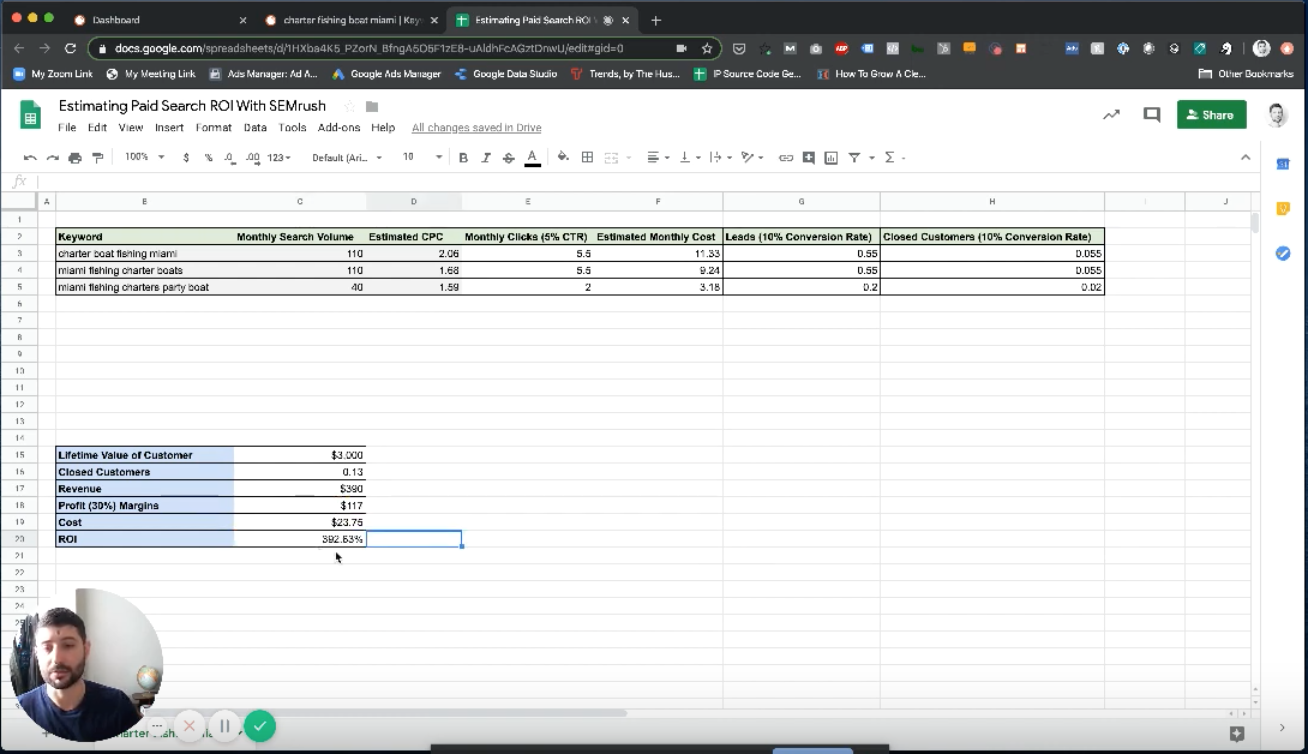How to Estimate ROI from Google Search Ads with SEMrush

Before launching a paid search campaign with Google AdWords, it’s only natural to want to estimate the return on investment (ROI) you can expect from your search ads.
However, calculating the ROI from a paid search campaign with any degree of accuracy is difficult, because so many factors play into the success of the ads. Everything from website conversion rates to sales team effectiveness impacts ROI.
That being said, if you’re confident in your website’s ability to convert clicks to leads and in your sales team’s ability to bring leads on as customers, a tool called SEMrush can help you come up with a loose estimate to inform your campaign planning and budget.
SEMrush provides data around how many people are searching for certain keywords each month, which tells you how competitive—and thus how expensive—it’s going to be for you to get that traffic to your website. If you know the conversion rates of your website and your sales team, and you know the lifetime value of your customer, some basic math can help you figure out what the estimated ROI would be for a paid search campaign around your keywords.
This is not a 100% perfect method. You’ll get the best data by actually running search ads for a couple of months and seeing what happens. But SEMrush is helpful for pulling together a loose estimate ahead of your campaign launch.
SEMRush: How it Works
SEMrush is an extremely useful search marketing tool. At BlueWing, we use it almost every day. With SEMrush, you can plug in any website—your competitors, your website, or any other—and SEMrush will generate a bunch of reports. Those reports will tell you whether the websites you plugged in are ranking organically for specific keywords, and what keywords the sites are targeting with paid search campaigns.
SEMrush is also helpful for general keyword research. Input any keyword you’re considering for a paid search campaign, and SEMrush will pull up related keywords that you can also target. Let’s say you input the keyword “car insurance.” SEMrush might tell you that people are also searching “where to buy car insurance,” “best car insurance rates,” and other popular keywords.
Estimating Paid Search ROI with SEMrush: Getting Started
We can bring the process of estimating ROI with SEMrush to life with a hypothetical example. (To see the tool in action, check out the video above).
Let’s say that we’re doing an estimate for a company that offers charter fishing boat rentals in Miami. Our main keyword, naturally, will be “charter fishing boat in Miami.”
The first thing we’ll do is set up a spreadsheet. That’s where we’ll add the data from SEMrush and from what we know about our hypothetical company’s conversion rates, in order to estimate the ROI for our paid search campaign.
Then we’ll jump into SEMrush, and start with our magic keyword: “charter fishing boat Miami.” Once we input that, SEMrush will give us bunch of related keywords.
Within SEMrush, we get a number of data points. First, in the keyword column, we can see the actual terms that people are typing into Google. To the right of the keywords is volume. This tells us how many monthly searches are happening for this keywords in the United States. For example, SEMrush is telling us that 110 people in the United States search for “charter fishing boat Miami” each month.
The next very important data point to review is the CPC, or cost per click, for each search term. In our example, SEMrush tells us that running search ads against the keyword “charter boat fishing Miami” is going to cost us around $2.06 per click to our website. This is a key data point to help us estimate our ROI.
Estimating Paid Search ROI with SEMrush: Adding Data Points
Once we have the data from SEMrush, we jump back to our spreadsheet. It’s a good idea to compare a couple of related keywords from SEMrush with your main search term, just to get a sense of how many terms you should include.
For our hypothetical company, we already have “charter boat fishing Miami” and “Miami charter boats” in our spreadsheet, and now we’re going to add “Miami fishing charters party boat.”
The monthly search volume for “Miami fishing charters party boat” is 40. The estimated cost per click is $1.59. Once we put those two data points into the spreadsheet, the formulas get to work.
A good click-through rate (CTR) for AdWords campaigns is 5%. If you can get 5% of the people that are searching for your keyword to click on your ad, you’re succeeding. Click-through rates of 10% or above are exceptional. In this hypothetical case, let’s be conservative and assume that we can get a 5% CTR on our charter-boat ad.
Estimating Paid Search ROI with SEMrush: Doing the Math
Now we can begin to estimate the ROI from our paid search ads by calculating our approximate monthly costs. We do this in two steps. First, we multiply the monthly search volume by our click-through rate of .05. For 40 searches a month, that means two clicks to our website. Then, we multiply our monthly clicks by the estimated cost per click from SEMrush.
Our ads for “Miami fishing charters party boat,” getting two clicks per month at $1.59 per click, will cost us $3.18 per month. Now: how many of those clicks are actually going to become leads? How many of those clicks are actually going to fill out a contact form or call us once they come to our website?
At BlueWing, we’ve seen conversion rates of 20% or even 30% for some of our customers, but let’s be conservative and say that 10% of our clicks on charter-boat ads will become leads. So each month, our two clicks will turn into 0.2 leads.
The final data point for estimating our ROI for paid search ads is the percentage of our leads that will turn into closed customers. Taking a conservative approach again, let’s assume that 10% of our leads become customers. That means that each month, our 0.2 leads become 0.02 closed customers from this single search ad.
Overall, from our three search keywords, we’re getting 0.13 closed customers per month and spending $23.75 on the clicks.
Estimating Paid Search ROI with SEMrush: Final Step
To get our final ROI estimate, we need to input the lifetime value of a customer. In this case, we’ll use the revenue total for a closed deal. For our hypothetical example, let’s say that a private charter boat rental costs $3,000.
If we multiply the lifetime value of the customer by the number of closed customers, that gives us a revenue value of $390. Assuming that we have a 30% profit margin, we’re making $117 in profit from customers gained through paid search ads each month.
To get our magic estimated ROI number, we just need to compare the profit from our campaign to the cost. We are making $117 each month, and we’re spending $23.75 to get that. Our ROI is the gain from that investment divided by the original investment, so our ROI for this paid search campaign is 392%.
Search marketing can be immensely powerful. The best way to see whether AdWords can drive results for your business is to try a small-budget campaign. The data will tell you whether it’s a channel to pursue more aggressively.
But if you know your lifetime customer value and your conversion rates, and you want to get a sense of the cost and return from a search campaign, SEMrush can help.
If you have questions or want to learn more about anything we covered here, please reach out to steven@bluewing.co.






